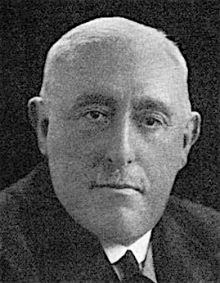
William Robert Crewe [commonly known as Bertie Crewe] was born in West Ham, Essex [now London], England in 1863 and was articled to Clement Dowling (1841-1906) in London. He also studied for three years at the Atelier Laloux in Paris. Following his return to London, he worked as an assistant to the theatre architect Thomas Walter Lawrence Emden (1847-1913) for two years and to William George Robert Sprague (1863-1933).
From c.1889 to 1895 he was in partnership with Sprague, and in 1895 he commenced independent practice in London. In 1916 Crewe formed a new partnership with Herbert Gordon Kay which continued until Crewe's death two decades later.
Crewe died in Willesden, Middlesex, 10 January 1937
A biographical file on William Robert "Bertie" Crewe is available on request at the Enquiry Desk, Royal Institute of British Architects Library, London
During a career that stretched over nearly fifty years, in which he specialised in entertainment architecture. In all he designed or altered over 150 theatres, music halls and cinemas. These included the Royal Court Theatre, London (1888); Theatre Royal, Lincoln (1889); Olympia Theatre, Shoreditch, London (1889) ; Olympic, London (1890); Theatre Royal, Aldershot (1891); Metropole Theatre, Camberwell, London, with Sprague (1894); New Bedford Theatre, Camden, London (1898); Euston Theatre of Varieties, Euston (1900); Century Cinema, Kings Cross, London (1900); Victoria Theatre, Salford, Lancashire (1900); Sadler's Wells, London (1901); Liverpool Royal Hippodrome, Liverpool (1902); Hippodrome, Brighton, Sussex (1902); Lyceum, London (1904); Pavilion, Glasgow (1904); Palace, Glasgow (1904); New Orient Theatre, Bedminster, Bristol (1904); Theatre Royal, Bury St Edmunds (1906); Sheffield Hippodrome, Sheffield (1907); Royal Hippodrome, Belfast (1907); Nottingham Hippodrome, Nottingham (1908); Hippodrome, Plymouth, Devon (1908); Oldham Palace, Lancashire (1908); Hoxton Hall, London (1909); Southend Hippodrome, Southend-on-Sea (1909) ; The Hipperdrome, Bedminster, Bristol (1909); Kingston Empire, Kingston upon Thames, Surrey (1910); Palace of Varieties, Glasgow (1910-11); Stoll Opera House, Kingsway, London (1910-11); Shaftesbury Theatre, Shaftsbury Avenue, London (1911); London Opera House, London (1911); Empire Burnley, Burnley, Lancashire (1911); The Hippodrome, Aldershot (1913); Golders Green Hippodrome, Golders Green, London (1913); Palace of Varieties, Manchester (1913); Palace, Redditch (1913); Coliseum Theatre, Dublin (1915); Birmingham Hippodrome, Birmingham (1899); Piccadilly Theatre, London (1928); Phoenix, London (1930); Saville, Covent Garden, London (1931); Regal Cinema , Kennington, (1932); Capitol Cinema, Southgate, London (1935). Most of his work was in Britain, however, he also designed the Mogador Palace and Alhambra in Paris in 1904 and the Alhambra in Brussels in 1907.
Avery, Derek. Victorian and Edwardian Architecture. London: Chaucer Press, 2003
Directory of British Architects 1834-1914. Compiled by Antonia Brodie, et al. Volume 1: A-K. London; New York: British Architectural Library, Royal Institute of British Architects/Continuum, 2001
Gray, A. Stuart. Edwardian architecture: a biographical dictionary. London: Gerald Duckworth & Co., Ltd., 1985
Heathcote, Edwin. Theatre London. London: Ellipsis, 2001
'Obituary'. The Builder vol. 152, 1937 pp. 156, 252